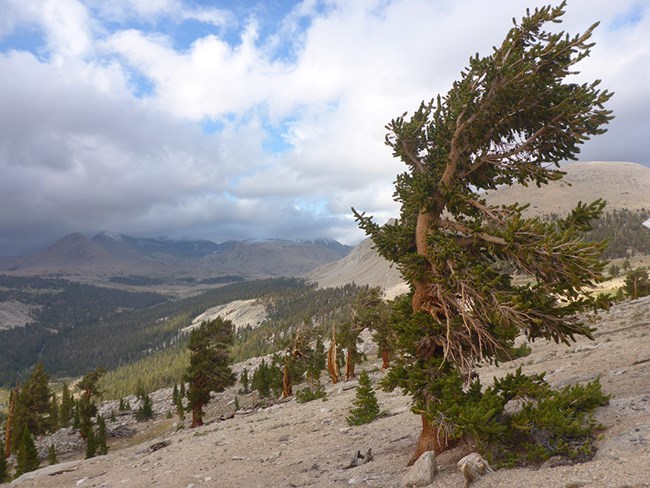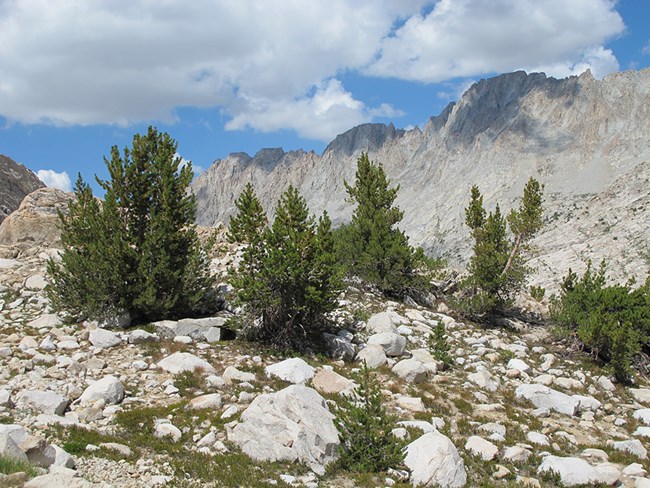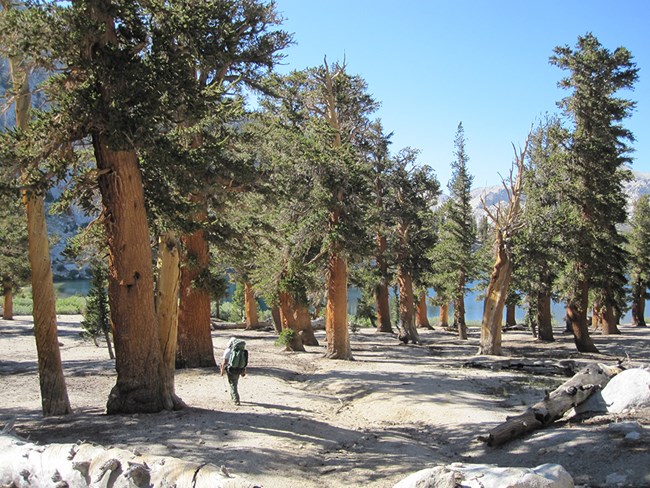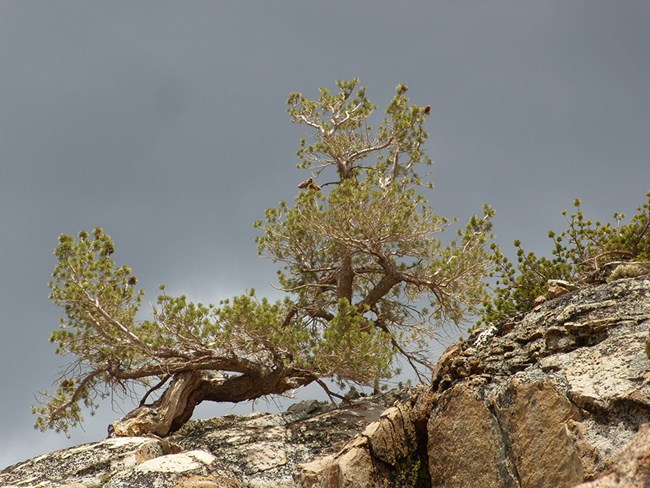
NPS photo Subalpine forests define the upper limit of tree growth in the Sierra. Trees in these forests can range from over 75 feet in height to the stunted and gnarled growth forms known as krummholz ("crooked wood" in German). Although occasionally found intermingling with the lodgepole and red fir forests below, the subalpine species are typically found between about 9500 to 12,000 feet in the southern Sierra. Trees you may encounter in the subalpine zone include mountain hemlock, whitebark pine, and foxtail pine, and occasionally western white pine, limber pine, and western juniper. 
Photo courtesy of Peggy Moore Whitebark PineWhitebark pine has a wide geographic range in the west, including in the Rocky Mountains, the Cascades, and the Sierra Nevada, where it reaches its southern limit near Mt. Whitney in Sequoia National Park. Whitebark pine occurs on both the west and the more arid east side of the Sierra crest in scattered treeline stands. The seeds of whitebark pine provide an important food source for many seed-eating birds and mammals. Whitebark pine is entirely dependent upon Clark’s Nutcracker (a medium-sized relative of the crow) for dispersal of its large wingless seeds. While severe declines in whitebark pine are occurring range-wide, Sierra Nevada populations are still relatively healthy. However, in recent years that has been changing. In 2021, local scientists and park staff began observing branch dieback and death of whitebark pine trees in some areas. This has often been associated with bark beetles or occasionally with signs of white pine blister rust infection. 
Photo by Linda Mutch Foxtail PineIn contrast to whitebark and limber pine, foxtail pine has a limited distribution. It is endemic to California and is confined to two discrete regions: the Klamath Mountains of northwestern California and the southern Sierra Nevada. Foxtail pine always grows as an upright tree (not a shrubby krummholz form), even on the highest, most windswept and exposed sites. These trees are limited to high-elevation slopes, ridges and peaks, typically growing in open stands that are almost purely foxtail pine with little other vegetation. Like the whitebark pine, foxtail pine provide important habitat and food for birds and mammals. The oldest known foxtail is over 2,000 years old. Both live and dead wood of this species can be dated to produce multi-millennial tree-ring records used to reconstruct long-term variations in climate. 
Photo courtesy of Connie Millar Limber PineLimber pine has a large distribution across western mountain ranges and occurs in a wide range of environments from lower elevation sites to treeline. It is uncommon in Sequoia and Kings Canyon National Parks, but extensive stands occur east of the Sierra crest in the Inyo National Forest and in the White Mountains of eastern California. It is a spreading or sprawling tree of high windy ridges and dry slopes. Limber pine is a pioneer on severe sites, moderating the environment to facilitate establishment of other species. Near its upper limits, the trunks of limber pine often arch over like a crescent and the treetop touches the ground as a result of centuries of harsh winds. Its seeds are food for numerous birds and mammals and are dispersed by Clark's Nutcrackers and small rodents. ThreatsAll three of these treeline species, in addition to western white pine that also occurs in the subalpine zone, are threatened by a non-native pathogen that causes the disease white pine blister rust. This disease has caused severe declines in whitebark pine in other parts of its range, but local populations are still in good condition. Other threats include mountain pine beetle outbreaks and the warming temperatures and changes in timing and type of precipitation from climate change. By conducting long-term monitoring of whitebark and foxtail pine, scientists will be able to help managers plan for short- and long-term changes in these forests. Watch the video below to learn more about the importance of these iconic trees, where they grow, and how they are monitored.
Visit our keyboard shortcuts docs for details
Join field biologists as they monitor beautiful whitebark pine and foxtail pine forests in areas of Sequoia and Yosemite national parks that are at the rugged upper limits of where trees can survive. Learn more about high-elevation forests. |
Last updated: September 28, 2023
